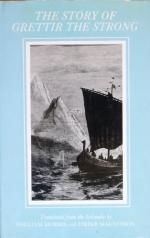veneration, and must always accompany the chief if
he moved his abode, and point out his new homestead,
if he fared for it over sea, by the spot where they
drifted ashore, as, when land was sighted, they were
thrown overboard. In front of the seat-rows just
described were placed the tables whereon the meals
were put forth. And when the number of people
exceeded the capacity of the ordinary benches, a new
row of benches was placed in front of the tables,
so that there were two rows of benches down along either
side of the hall with the tables between them.
The last-named rows of benches were called
forsoeti;
and their occupiers, when seated at table, faced those
of the upper and lower bench. In the centre of
the hall, if of the fashion, as it probably was in
early times, of a fire-hall, was a narrow oblong stone-pavement,
probably as long as the rows of the benches, whereon
fires were lit for heating of the room, for cooking
of food in some cases, and for the purpose of lighting
up the hall. The smoke that rose from the burning
fuel found its way out through the luffer or louvre,
in the middle of the ridge of the roof (
ljori);
the
reyk-beri, reek-bearer, seems to have
been a contrivance for creating draught to carry the
smoke out through the
ljori. In that
end of the hall which was opposite to the entrance
was the cross-bench, dais (
pallr), occupied
by the women. Here was also a high seat (
oendvegi
a palli), which was generally taken by the
mistress of the house. In our saga it seems that
the hall of Sand-heaps made an exception to this general
rule, as it apparently had the dais immediately within
the doorway.
P. 77 (cpr. 110). It is worth observing here,
that Thorvald, son of Asgeir Madpate the younger,
dwells at As in Waterdale, about 1013, when Thorgils
Makson was slain. When Grettir played, as a youth,
on Midfirth-water (or cca. 1010), he dwelt
at Asgeirsriver. We mention this because there
has been some confusion about the matter. On
the slight authority of the Þattr af Isleifi biskupi’,
Biskupa Soegur I. 54, it has been maintained that
he dwelt at Asgeirsriver even as late as cca.
1035, when his daughter Dalla was wooed by Isleif
the Bishop. G. Vigfusson, Safn til Soegu Islands,
I. 337. On the other hand, the statement of Hungrvaka
that he farmed at As (i.e., at the Ridge),
at the time aforesaid, has given rise to the conjecture
that thereby must be meant Valdar-As, a farm in Willowdale,
near Asgeirsriver, the manor of the Madpate family.
G. Vigfusson, in Biskupa Soegur, I. 61, note 2.
It seems there is no need of setting aside the clear
statement of our saga, that the As was As in Waterdale
(see Index), and not Valdaras in Willowdale
at all, or that Thorvald had, by 1013, moved up to
the neighbouring country-side of Waterdale, and settled
among the kin of his great-grandmother.
P. 114, 1. 1. ‘The men of Meals,’
is a close translation of the original, which, however,
is incorrect; for the men of Meals were Grettir’s
kin-in-law, and natural allies. The saga means
the men of Meal, Kormak and his followers, and the
original should be either, þeir Mel-menn, or Mels-menn,
or þeir Kormakr fra Mel.




